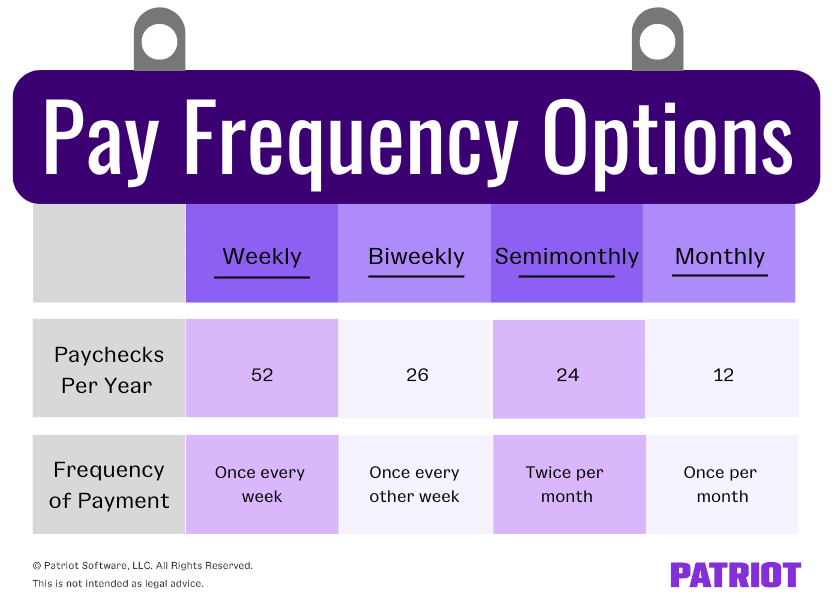Pay frequency is one of the first decisions you must make when you hire your first employee. If you haven’t thought about payroll frequency, now’s the time to start. Employee satisfaction, legal compliance, and cash flow may depend on it.
If you’re asking yourself what is pay frequency, no worries. You’re likely already familiar with it (even if you don’t know it by its official term). Regardless, we’ve got you covered.
Read on to learn:
- What is pay frequency?
- Pay frequency options in detail
- How to choose a payment frequency
What is pay frequency?
Pay frequency, or payroll frequency, is how often you pay employees. Your pay frequency also determines how often you must run payroll. There are four popular pay frequencies to choose from: Weekly, biweekly, semimonthly, and monthly.
Your frequency determines the number of paychecks an employee receives in a year. This influences each paycheck’s wage and tax amounts. However, pay frequency doesn’t impact an employee’s annual tax liability or net pay (over time, it all equals out).
Because it determines how often you run payroll and pay employees, the frequency you choose can also impact your:
- Time commitment: Running payroll by hand takes time. The more frequently you pay employees, the more time you spend running payroll.
- Money: Want to save time running payroll by using software? Great! But, some payroll software companies charge you based on the number of payrolls you run each month.
Pay frequency options in detail
Pay frequency meaning? Check. Now, it’s time to look at each of the four options—weekly, biweekly, semimonthly, and monthly—in detail.
Weekly
Under a weekly pay frequency, employees receive their wages each week. An employee paid weekly receives 52 paychecks per year.
Each paycheck is less money and more frequent than other frequency options. You must run payroll more often than with any of the other frequencies.
According to the U.S. Bureau of Labor Statistics, 33.3% of employees receive weekly paychecks, making it the second most popular frequency.
Biweekly
With a biweekly pay frequency, you pay employees every other week. Employees who get biweekly wages receive 26 paychecks per year.
Employees receive their wages the same day of the week each pay period, like on a Friday. Typically, employees receive two paychecks each month. However, there are two months in the year when employees receive three paychecks instead of two (so plan your budget accordingly!).
According to the BLS, 43% of employees receive their wages biweekly, making it the most popular pay frequency. One reason for the popularity is that biweekly pay is a happy medium between weekly and monthly pay frequencies.
Semimonthly
It can be easy to confuse semimonthly pay frequencies with biweekly schedules. Under both frequencies, employees receive wages twice per month with both (for the most part). But, there are a few key differences between biweekly vs. semimonthly pay. Under semimonthly pay, employees receive 24 paychecks per year.
With a semimonthly pay frequency, you pay employees on specific dates, but the days might differ. For example, you can pay an employee on the 15th and 30th of each month. These dates can fall on any day of the week.
A semimonthly pay frequency can be difficult for employers and employees to track. Employees can receive their wages on a Tuesday or a Friday, all depending on the day the date falls.
Semimonthly pay frequencies are the third most popular payment option. Nineteen percent of employees receive their wages on a semimonthly basis.
Monthly
If you pay employees monthly, they receive one paycheck per month. An employee paid monthly receives 12 paychecks per year.
Monthly paychecks are for larger amounts of money but are less frequent than other frequencies. Monthly paychecks can make financial planning difficult for some employees.
Only 4.7% of employees are paid monthly, making it the least common pay frequency.

How to choose a payment frequency
Every business is different. Before you create a pay frequency schedule, consider the following four factors:
- Pay frequency laws
- Your employees
- Your industry
- How you run payroll
1. Pay frequency laws
Are there pay frequency laws you have to follow? Yes—and no.
There is no federal law that says what frequency you must choose. However, you must keep a consistent frequency. You cannot change up an employee’s frequency when you feel like it.
Pay frequency requirements by state determine what pay frequencies you can and can’t use. Most states set a minimum frequency you must follow. For example, Arizona requires that employers pay employees two or more days per month, not more than 16 days apart.
So before deciding on frequency, check with your state laws.
2. Your employees
How many employees do you have? Are your employees salaried or hourly? These employee-related factors may impact the frequency you go with.
Number of employees: According to the BLS, employer size can determine pay frequency. For example, 70% of businesses with 1,000+ employees use biweekly, compared to 34.9% for businesses with one to nine employees.
Hourly vs. salary: The type of workers you employ can also affect your business’s payroll frequency. You can establish different pay frequencies for salary vs. hourly employees (although this might get confusing if you run payroll by hand).
3. Your industry
What industry is your business in? For some companies, industry determines your frequency. Certain industries tend to pay weekly, while others tend to pay monthly.
According to the BLS, 73.9% of construction employers pay employees using a weekly schedule. But, only 7.1% of employers in the financial activities industry run weekly payroll.
4. How you run payroll
How do you run payroll? By hand? Using software?
If you run payroll by hand, shorter pay frequencies (i.e., weekly) require more payroll runs, which takes up more time and energy.
Payroll software can significantly cut back the time you spend running payroll. But again, some companies have additional fees and charge per payroll run. You could end up paying more to run weekly payrolls than running biweekly, semimonthly, or monthly payrolls.
Need a way to keep your payroll under control? With Patriot’s online payroll, you pay per employee, not per paycheck. So go ahead and run unlimited payrolls—we won’t charge more! Get your free trial today.
This article has been updated from its original publication date of October 30, 2014.
This is not intended as legal advice; for more information, please click here.


